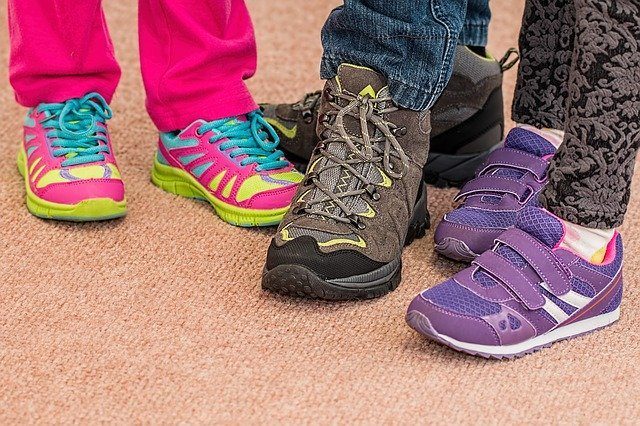Parents consult with Rachel for many reasons:
- You may be concerned about your child’s development.
- Your child complains of pain.
- There may be other signs that your child is experiencing discomfort, such as a reluctance to walk, run or participate in sports. Your child may not want to join in with other children’s physical activities.
- You may have been referred from a health professional or teacher.
- Your child may have an inherited, congenital or neurological condition that can be supported with the help of a podiatrist.
- Some overuse injuries are more common in children, especially during the period of rapid pubescent growth when they can be taking part in intense sports activities. There can be multiple factors causing injury and a thorough diagnosis from an experienced podiatrist may help lessen the recurrence of overuse injuries.
Your child may have been referred to Rachel for an assessment by your Consultant, GP or other medical professional or you can self-refer because you have concerns and want your child to be seen by a highly experienced podiatrist. The treatment of children’s lower limb conditions is called podopaediatrics.
Links to some common children’s foot types and conditions:
- Hypermobility in children
- Ingrown toenails
- In-toeing, out-toeing, toe walking, curly toes
- Flat feet in children
- High arches in children
- Osgood-Schlatter disease
- Patellofemoral pain syndrome
- Sever’s disease
Some of the above foot types and conditions are normal in children and do not need any medical intervention and some ailments are straightforward to treat. However, if you have concerns that there are signs of a problem with your child’s feet or the way your child walks, a comprehensive biomechanical assessment can give an early diagnosis along with a treatment plan.
Causes of children’s foot problems
Children’s foot problems can have several causes which can include:
- neurological or muscular problems
- inherited conditions
- congenital disorders, present from birth
- sports related injuries and accidental injury
- some problems can be idiopathic, from an unknown cause
Podiatry for Children
Rachel treats routine chiropody conditions in children including:
Please note, Rachel does not treat verrucas.
For more information about chiropody and podiatry see the Podiatry page. For ingrown toenail and nail surgery for children see the Ingrown toenails page or the Nail surgery page.
Should you want to discuss any of your children’s needs before their appointment do call the clinic on 020 8348 5553 and leave a message for Rachel who will call you back within the next 24 hours.
Biomechanical assessments, podopaediatrics, for children
A biomechanical assessment and gait analysis investigates irregularities in the way your child moves and the structure of their feet to assess how to treat many conditions that can affect them. It may help diagnose disorders of the heel, ankle, foot, knee, hip, back and neck. The assessment can also aid in identifying any underlying causes, which can be multi-factorial, that may have made your child more susceptible to conditions causing pain, discomfort or injury.
For a more comprehensive explanation of biomechanics, gait analysis and orthotic insoles see the Biomechanics page or the Orthotic insoles page.
What happens in a biomechanical assessment consultation for children
A biomechanical assessment for children lasts 45 – 60 minutes and a full medical history of your child will be taken. The consultation is a quick and painless procedure.
If your child is coming to see Rachel for a biomechanical assessment, dress them in loose comfortable clothing and bring their old shoes if possible as well as any old orthoses they may have. These old shoes are useful to see how your child wears their shoes and how their shoes have worn. Do bring any toys, books, drinks or snacks that your child may enjoy.
Treatment can include:
- Self help advice
- Footwear advice
- Stretching and strengthening exercises
- Postural advice
- Medication
- An orthotic insole
If your child is prescribed a bespoke orthotic insole, a cast is taken of your child’s foot during the consultation. The taking of this cast is also a painless procedure. From this cast, a custom-made insole is made which exactly fits the individual characteristics of your child’s foot. An orthosis can help support, cushion and stabilise the foot, which may help alleviate some painful conditions. See the Orthotic insoles page for more information about bespoke orthotic insoles.
Rachel is a very experienced practitioner of pediatric podiatry who is patient and gentle with children of all ages. She has extensive experience in conducting biomechanical assessments and has treated many children, helping them to achieve better foot health and function.
Contact the Clinic for an appointment
Rachel Miller sees many children for a wide variety of conditions at her clinic Highgate Podiatry in Highgate Village, 14 Pond Square, N6 6BA, London. Clinics are held every Wednesday, Thursday and Sunday. Please contact the clinic for an appointment on 020 8348 5553. For Highgate Podiatry’s address, map and directions see the Contact page.
Links to Services:
Links to Conditions Treated Include:
- Achilles tendinopathy
- Ankle fractures
- Ankle injuries
- Arthritis
- Back pain
- Bunions
- Corns/Calluses
- Diabetic care
- Flat feet
- Fungal toenail/athlete’s foot
- Haglund’s deformity
- Hammer toe and mallet toe
- Heel pain
- High arches
- Hypermobility
- Ingrown toenail
- In-toeing, toe walking, curly toes
- Knee injuries
- Metatarsalgia
- Morton’s neuroma
- Osgood-Schlatter disease
- Overuse injuries
- Patella tendinopathy
- Patellofemoral pain syndrome
- Plantar fasciitis
- Sever’s disease
- Sprained ankles
- Stress fractures
- Tarsal tunnel syndrome
- Toenails






